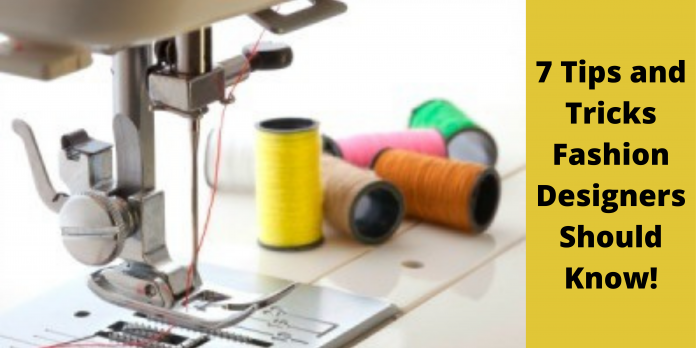7 Tips and Tricks Fashion Designers Should Know!
Are you a first-time user of a sewing machine? Then you should read this article! I’ve included a few tips and tricks from my own experience that are simple to implement and would help you get the most out of your sewing machine. I hope you find them useful.
1) Select the most suitable machine.
If you are already having a sewing machine, you can skip this step (and make do with what you have). However, if you decide to purchase a sewing machine, there are several models to choose from that are best suited for beginners.
The advantages of those models are too numerous to list here, but I strongly encourage you to read through a few of the product descriptions to get a sense of what I’m talking about.
2) Make use of threads that are the same colour.
A sewing machine uses two threads to complete a stitch. To avoid uneven tension, jams, and breakages, you should always use the same type of thread (same material, same thickness*) on the garment’s top and bottom.
*Of course, you can mix colours (to match the inner and outer fabrics or create decorative stitching) as long as the threads are the same type as the inner and outer fabrics.
The most straightforward method of matching threads is to begin each project with an empty bobbin and fill it with thread from the spool.
If you frequently use the same spool, fill several bobbins at once to save time by not re-threading your machine every time you use it.
Maintain track of where they came from at all times. (Each bobbin should be labelled or stored with its corresponding spool.)
3) Make sure your lines are straight, and your curves are smooth.
If you’ve never used a sewing machine before, this may appear to be a difficult task; however, it is quite simple (although you will need some practice).
Stitching a straight line requires aligning one of the edges of your fabric with one of the lines* on the needle plate and maintaining that alignment throughout the stitching process.
*These lines can be found on the majority of sewing machines. If you don’t have one, you can make one by sticking a piece of tape to the needle plate.
It would be best to begin by moving slowly and gradually increasing your speed as your confidence grows.
Always keep your attention on the alignment, rather than the needle or the stitching, because they move too quickly for your eyes to keep up with them, and it prevents you from seeing the bigger picture.
In order to create a smooth curve, stitch slowly while rotating the fabric with both hands at the same time.
If possible, stitch in a steady, continuous motion; if you are unable to (or if you must make a sharp turn), always come to a complete stop with the needle firmly embedded in the fabric. This enables you to pivot the fabric around the last stitch, resulting in a neat curve every time.
4) Hold on to the tails of the threads at the beginning.
Before you begin stitching, the tails of the threads are dangling loosely. This can cause them to become entangled in the machine’s mechanism, and in some cases, they can even pull the fabric into the machine with them (especially light, thin fabrics).
Always hold the tails of the threads with your left hand while making the first stitches to avoid creating a tangled mess (and possibly having to cut a hole in your fabric to fix the problem).
5) Press your fabrics before sewing them together.
By flattening the fabric before sewing, you can avoid the crooked stitches that result from sewing scrunched up the fabric. Simply smooth out all of the lines (including the neat folding ones) with your hands if that is sufficient, or iron it if more is required.
It will take some extra attempt to get started, but it will pay off in the long run by making your life easier.
6) Put in the time and effort to perfect your craft.
Practice makes perfect, and that’s exactly how you want your work to appear, don’t you think?
I understand the temptation to jump right in and get things going. However, it is important to note that each type of fabric, thread, and stitch has its own set of characteristics.
Different threads require different tensions; thin fabric can be fragile, whereas thick fabric necessitates the use of a thick, strong needle; stitches are available in various shapes and sizes; and so forth.
By spending a few minutes practising on a scrap of fabric, you will be able to make adjustments without ruining your work. It goes without saying that you must recreate the circumstances of your project for this to make sense.
To ensure consistency, use the same fabric (and several layers), thread, and machine configuration for both your test run and your final project.
Complete beginners can also practice on printed paper to get the hang of it before moving on to the computer. There are many free patterns (lines, curves, and even drawings) available online that you can print at home and use for exercise.
7) Maintain the best possible sewing conditions.
Clean the machine, re-thread it, or change the needle, and you’ll be surprised at how many mechanical glitches can be resolved this way.
Rethreading is yet another maintenance procedure that can keep things running smoothly. In case you can’t seem to get the tension right if the thread keeps jamming or breaking, or if anything feels wonky, you should try re-threading it all (spool and bobbin). This will almost always solve your problem.
When it comes to needles, make sure to use the right one for the job at hand. Although universal needles are useful in various situations, they are not always the best option.
The needles will not perform as well on very thin or thick fabrics as they will on thinner or thicker fabrics.
Jeans, for example, maybe your go-to outfit, but they require more than your standard sewing machine needle!
Needles can also become blunt or bent in a short period. This can result in thread jams or, in the worst-case scenario, the needle crashing into the needle plate instead of passing through the opening (and consequently breaking). It should be changed regularly to ensure better and safer stitching.
We appreciate you taking the time to read!
Finally, we hope you found this article interesting? And what do you think about ”7 Tips and Tricks Fashion Designers Should Know!?”
Please feel free to share your thoughts with us in the box below.
Check the facts
With accuracy and impartiality, we endeavour to deliver the most up-to-date essential information for fashion enthusiasts.
Please contact us if you would like to contribute to this article or advertise with us.
And let us know if you notice something that isn’t quite right.













